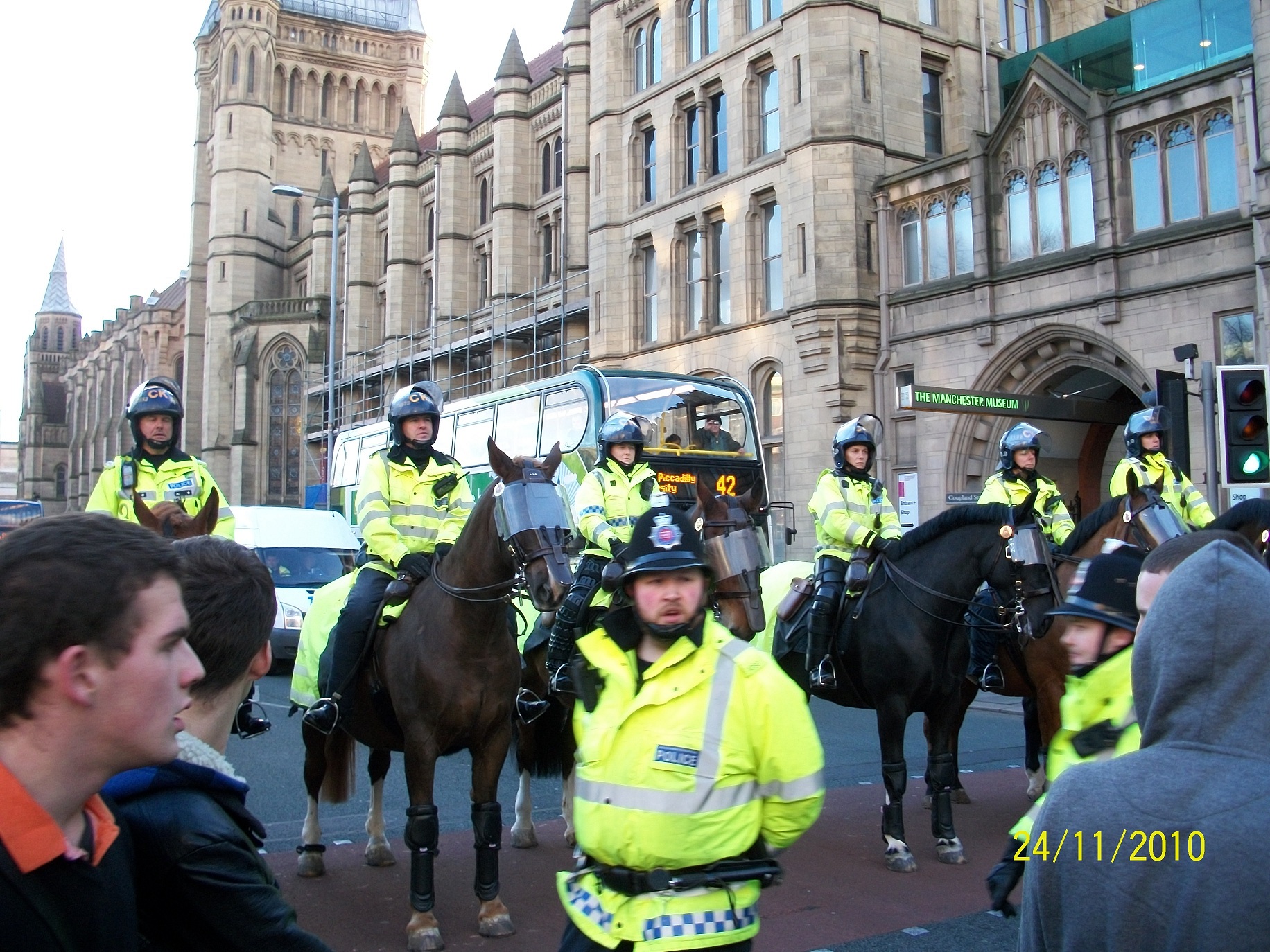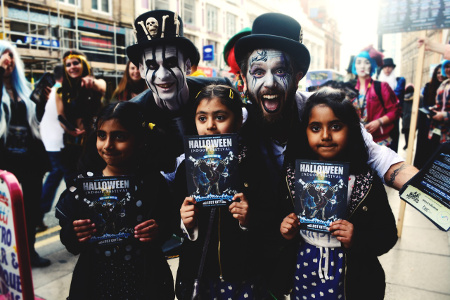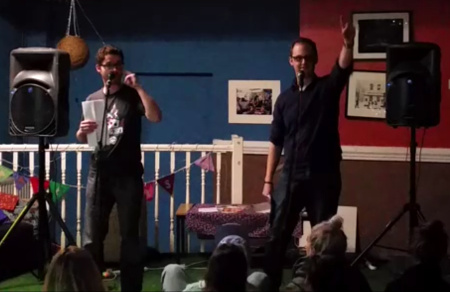Students complain of GMP violence
Article published: Monday, November 29th 2010
Participants of the 24 November student protest in Manchester have spoken out with allegations of police violence directed towards demonstrators following Greater Manchester Police’s (GMP) claim that the demonstration had been a “success” that “passed off peacefully.” Additionally, video evidence of a charge by police horses into a densely packed crowd of demonstrators has emerged, contradicting GMP’s assertion that such a movement was never carried out.
In an echo of scenes in London on the same day, two separate videos show police horses stopping and lining up in front of protesters blocking Oxford Road outside Whitworth Park, before moving at speed through the crowd, many of whom were sitting down.
When contacted by MULE on Friday, GMP’s press office said there was no evidence to suggest that police horses had been used to charge the crowd, and that having spoken to the Superintendent in charge of the operation there was “nothing from our side to suggest that this happened.”
However, two videos of the charge had already been uploaded to YouTube, one of which was being discussed in a GMP Police Forum at 9:51 AM on the morning after the protest, where a poster wrote that: “Our ‘Film and be filmed’ mentality has resulted [in] some great tactical shots of containment and dispersal.”
No Warning
The incident took place at around 4pm outside the Manchester Royal Infirmary on Oxford Road. Students were blocking the road, with many sitting down and not behaving aggressively or inciting the officers. They also do not appear to have been warned. Sarah Riddel, a care worker from Manchester, told MULE: “I didn’t see the order for the charge, or where it originated from, and there was no real organised line there anywhere, there was no-one with anything like banners, shields, anything, that they were charging at. There were three or four horses cantering at the protesters.
“I used to ride horses, and the speeds are walk, trot, canter, gallop. The leg movements are different; cantering involves a lot of leg movement which is how I know. It was more than just walking them…It was unnecessary, the numbers [of protesters] weren’t increasing.”
 Protesters assert that the horses moved into the crowd with no warning, leading to at least one woman being injured. Sam Darlington, a student from Manchester Metropolitan University (MMU), said: “We were not given a chance to move and, while I narrowly avoided being hit, my friend had a bone in her foot dislocated and another broken after she was trampled by a horse. Afterwards, the police did little to help her find medical attention.”
Protesters assert that the horses moved into the crowd with no warning, leading to at least one woman being injured. Sam Darlington, a student from Manchester Metropolitan University (MMU), said: “We were not given a chance to move and, while I narrowly avoided being hit, my friend had a bone in her foot dislocated and another broken after she was trampled by a horse. Afterwards, the police did little to help her find medical attention.”
There were significant numbers of college students and schoolchildren under the age of 18 present throughout the day, and many were sitting down in the road at the time of the charge. During the charge an executive member of the University of Manchester Students Union (UMSU) told the police of their presence through a megaphone. According to Zoë Creighton-Hird, a student at the University of Manchester (UoM), the mounted officers had also been warned previously: “We tried to tell the police that there were kids present and they’d be in the way. And then, I’m not sure how many it was, but maybe three or four horses just broke through the police lines and went into the crowd.”
Creighton-Hird also reported that one unmounted officer was visibly shaken after witnessing the charge. When she asked if the charge was not unsafe, the officer replied that the police in his line “didn’t know that was going to happen.”
The horses were also reported to have become distressed after the charge, at which point they had been among noisy crowds for around two hours, and were seen to be giving their riders difficulty: “In front of us were two horses, and the policewoman on the horse behind was giving hints to the other horse rider how to calm it down. That was pretty scary, because they were clearly not in control,” said Creighton-Hird.
Simon Bradley, also a student at UoM, thought the horses were distressed and acting dangerously: “Some of the horses were clearly nervous, to the point where they were just kicking out. At one point, a horse swung round really fast and hit my friend, and when she shouted at the officer on the horse to be more careful, he just shouted abuse back at her.”
Riddel also saw horses that seemed out of control: “There were two that were really skittish. One of them was kicking out into the crowd, the police woman would have been able to feel it, the rug had swept to one side so it [the horse] was kicking into the crowd. She didn’t make any effort to direct the kicking away from the crowd, which is unacceptable. Again, the people on the left of me were schoolkids, and she made no effort at all.”
One History PhD student at UoM suggested GMP officers were fully aware of the danger. He witnessed a police horse being maneuvered in front of a group of protesters on the road outside the Manchester Museum, while the mounted officer riding it shouted to the group now behind her to “get out of the way because this horse kicks.”
“This was an hour or so before the charge and essentially the officer was admitting she did not have full control of the horse. The guy standing next to me shouted ‘well why did you bring it then?’, but she ignored him. It seems insane to be attempting crowd control when you can’t even control the horse.”
Despite the kicking risk, the horses were placed close to crowds with their backs facing them. “They were using police horses to move people out of the way. They were just kind of reversing the police horses into the crowd, then saying it’s dangerous to be behind them, so that people would run out of the way,” said one protester.
Violence and intimidation
After the charge demonstrators allege the police began to lose patience with the crowd and launched unprovoked physical attacks, even though they were now standing on the pavement. A video reveals that at the end of the charge a protester was seized by the collar by an officer, who leans into his face before turning away saying “you’re not hard enough, go away.”
In a separate incident, Bradley referred to his treatment by officers as “being basically assaulted without provocation. I wasn’t even blocking any police officers, and two police officers grabbed me, picked me up, and threw me onto the ground.”
Creighton-Hird then witnessed the same officer restraining and shouting at another protester. “The cop that hit Simon was gripping a young man round the shoulder and yelling at him. He shoved me on the shoulder, and I said ‘don’t touch me’, and he responded saying that it won’t be the first or the last time. I later found out that was the same guy who hit Simon, since I remember his number and someone else said his number. It was 5661.”
A man who was not part of the protest was seen leaving the MRI before being accosted by a police sergeant. One of the witnesses, a teaching assistant at UoM, described the scene in an email to MULE: “a man in a suit came out of MRI and tried to walk past a police line. Without warning, Sergeant 6884 pinned him against the railings, squeezing his neck with his fore-arm while shouting in his face.”
Physics student Toby Brett witnessed the same scene: “Sergeant 6884 pushed this guy back and prevented him from coming through. This guy was dressed in a suit and said that he was not part of the protest. The sergeant grabbed him by the shirt and shoved his forearm into his neck, and kept it there applying pressure. He held him against a railing and shouted at him. Then he let the guy go, and pushed him away.
“We talked to him afterward, he as very visibly shaken, as was his partner. He said he’d just left the hospital. He was angry and shaken and confused. We asked them if they wanted to make an official complaint but he was too shaken.”
After this, the witness watched the same officer violently restrain another man in the crowd: “While I chatted to the man from the hospital, Sergeant 6884, again apparently without provokation, pulled a young man from the crowd. He punched him on the head and then headlocked him. Bystanders were shouting at the sergeant to stop. Then a different officer wrestled the man onto the floor and took him away.”
 Some eyewitnesses described seeing female protesters being dragged away by their hair, with one supplying a photograph that he claims shows four officers restraining a women in this manner. A video from the same source shows numerous officers pushing everyone they come across outside the student’s union, sending one woman falling into the camera.
Some eyewitnesses described seeing female protesters being dragged away by their hair, with one supplying a photograph that he claims shows four officers restraining a women in this manner. A video from the same source shows numerous officers pushing everyone they come across outside the student’s union, sending one woman falling into the camera.
Arrests
GMP acknowledged all 17 arrests that day were for minor acts. However, demonstrators allege that these were largely made for spurious reasons, with the police behaving violently and inappropriately.
One PhD student witnessed the arrest of a young woman for ‘breach of the peace’, after she had reacted angrily to an officer pushing her: “At the town hall, the police were trying to move demonstrators off the road. One officer aggressively pushed a woman who was making her way to the pavement, nearly knocking her to the ground, and sneeringly calling her ‘sweetheart.’ When she turned round and shouted ‘don’t call me sweetheart,’ they arrested her for ‘breach of the peace.’”
Later in the day, the student witnessed one of the commanding officers take a mobile phone being used to film the police. When queried, “he provided no reason for his behaviour simply telling people to ‘fuck off’, before threatening to arrest me for swearing.”
Several others were also threatened with arrest for swearing. Phil Simpson, a student from MMU, said: “One officer grabbed me with force and shouted ‘if I fucking catch you swearing again, you’ll be in the back of my van, I got my eye on you.’”
In some cases the police went through with the threat, as witnessed by Liam Carberry: “Outside the museum on Oxford Road the police forced us on to the pavement with quite a bit of aggression. Me and my friends were talking and chanting and a police officer then pulled us and threatened to arrest a friend of mine for swearing.
“We argued with the police officer, we thought it was just a poor excuse to arrest him and others. A few minutes later my other friend was pulled to the ground by a small group of police because he swore!”
Sam Darlington alleges that he was arrested for obstructing an officer even though it was impossible for him to follow police orders: “I had been moved onto the pavement at which point I could go no further back because of the amount of people behind me. I was told three times to move and each time I responded that it was physically impossible for me to move. After the third time, I was pushed by the officer before another jumped in to help him drag me across the road.”
He added that he believes the arrests were made to scare participants in the protest: “I’ve heard numerous reports of people overhearing officers being told to ‘arrest a few to send a message.’”
GMP and UMSU respond
Assistant Chief Constable Garry Shewan said in an official statement: “The policing operation was a success as it passed off peacefully on the whole…We have received no formal complaints about the operation but we have received a number of messages of support and praise from members of the public and some students.”
Shewan made no reference to the fact UMSU executives had only been told at the last minute that the route had been changed and the march would end in Castlefield, not the Town Hall as planned and advertised. Although the march only ended at the original location because a large group of protesters broke through police lines at the Museum of Science and Industry, he asserted that: “Our operation allowed around 3,000 people to march to the city centre, make their legitimate protest, and return to the university area.”
In a statement, UMSU Campaigns Officer Amanda Walters said: “The police operation was not a success. Firstly, the police re-routed the march at 12pm to Castlefields rather than going to the Town Hall. This angered the protesters who broke off from the police’s planned march and made their way to the original end point. After this students headed back to the University of Manchester to stage a sit in on Oxford Road.
“The students, including many under 18, marched peacefully and held a peaceful sit-in. The heavy-handed nature of the police was completely unjustified. The police charge on horses onto protesters who were sat down was unnecessary. I hope this is not the beginning of more aggressive police tactics, which will only create a backlash.”
Andy Bowman and Tom Fox
More: Cuts, Education, Features, Policing
Comments
-
That’s an excellent piece of journalism, Andy Bowman and Tom Fox.
Comment by Jon Butcher on December 4, 2010 at 8:56 am -
[…] statement confirms a trend of the reporting of student demonstrations in Manchester. Despite a MULE investigation which collected over a dozen eyewitness accounts of violence and intimidation at the hands of police on November 24 – and video footage which unequivocally shows officers on […]
Pingback by GMP Chief joins anti-protest propaganda war — MULE on January 10, 2011 at 6:31 pm -
[…] peacefully”, a matter we consider unfortunate for the police considering their repeated efforts to make last November’s protest as violent as possible. Despite this concession, they are […]
Pingback by By repeating baseless attacks on students, MEN is the GMP’s enabler — MULE on January 28, 2011 at 11:19 am -
[…] in order to target ‘trouble-makers’. This is particularly controversial given the repressive policing methods used to quell the student […]
Pingback by Manchester prepares to march on London — MULE on March 24, 2011 at 11:07 am
The comments are closed.



